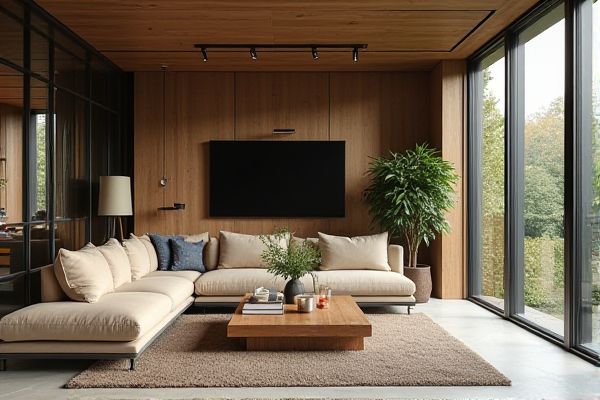
Biophilic design integrates natural elements, such as plants, natural light, and organic materials, to create calming, health-enhancing spaces, while industrial design emphasizes raw materials, exposed structures, and minimalist aesthetics for a modern, edgy feel. Discover how these contrasting styles can transform Your living or working environment by reading the rest of the article.
Table of Comparison
| Feature | Biophilic Design | Industrial Design |
|---|---|---|
| Core Concept | Integrates nature and natural elements to enhance wellbeing | Focuses on raw, exposed structural and mechanical elements |
| Materials | Natural wood, stone, plants, water features | Metal, concrete, exposed brick, steel, reclaimed wood |
| Color Palette | Earth tones, greens, blues | Neutral tones like grey, black, and white, with some rustic accents |
| Lighting | Natural light emphasis, use of daylight and skylights | Industrial fixtures, exposed bulbs, often dimmer ambient lighting |
| Texture | Organic textures, soft finishes, natural fibers | Rough textures, metal surfaces, concrete, exposed mechanical parts |
| Atmosphere | Calm, relaxing, nurturing connection with nature | Bold, rugged, urban, functional aesthetic |
| Common Spaces | Green walls, indoor gardens, water elements | Open floor plans, exposed ducts and pipes, factory-style accents |
| Purpose | Improve mental health, productivity, and creativity through nature | Showcase functional design and structural elements for visual interest |
Introduction to Biophilic and Industrial Design
Biophilic design integrates natural elements, such as plants, natural light, and organic materials, to enhance well-being and create harmonious indoor environments. Industrial design emphasizes raw, utilitarian aesthetics, featuring exposed brick, metal, and concrete surfaces that highlight functional simplicity and rugged textures. Both approaches shape spaces with distinctive sensory experiences, reflecting contrasting priorities between nature-inspired comfort and mechanical efficiency.
Key Principles of Biophilic Design
Biophilic design emphasizes integrating natural elements like sunlight, vegetation, and water features to foster a connection between people and nature, promoting well-being and productivity. It prioritizes organic shapes, natural materials such as wood and stone, and patterns that mimic natural environments to create calming, restorative spaces. This design philosophy contrasts industrial design, which highlights raw materials, exposed structures, and utilitarian aesthetics focused on function and minimalism.
Core Elements of Industrial Design
Industrial design centers on core elements such as functionality, durability, and aesthetic simplicity, often featuring materials like metal, concrete, and exposed steel. This design style emphasizes clean lines, utilitarian forms, and mechanical details that highlight manufacturing processes and structural integrity. Your space can benefit from industrial design's raw, edgy look, which contrasts sharply with the natural warmth and organic forms found in biophilic design.
Aesthetic Differences: Nature vs. Urban
Biophilic design emphasizes natural elements such as plants, organic shapes, and earthy colors, creating a calming and inviting atmosphere that mimics the outdoors. Industrial design features raw materials like exposed brick, metal, and concrete, highlighting a rugged, urban aesthetic with clean lines and utilitarian details. Your space can reflect either serene nature-inspired beauty or bold, urban sophistication depending on the design style you choose.
Impact on Human Wellbeing
Biophilic design enhances human wellbeing by incorporating natural elements such as plants, natural light, and organic materials, which reduce stress, improve cognitive function, and boost mood. Industrial design, characterized by raw materials like metal and concrete, may create a stark environment that can increase mental fatigue and reduce comfort if not balanced with softer elements. Integrating biophilic features within industrial spaces can optimize wellbeing by combining functional aesthetics with nature-inspired benefits.
Material Choices and Sustainability
Biophilic design emphasizes natural, renewable materials such as wood, bamboo, and stone, promoting sustainability through reduced environmental impact and enhanced indoor air quality. Industrial design favors raw, durable materials like metal, concrete, and exposed brick, often sourced for longevity but sometimes criticized for higher embodied carbon footprints. Integrating biophilic principles in industrial settings can improve sustainability by combining natural elements with industrial materials, optimizing both ecological benefits and structural resilience.
Space Utilization and Functionality
Biophilic design enhances space utilization by integrating natural elements that promote well-being and productivity, creating adaptable environments that respond to human needs. Industrial design emphasizes functionality through streamlined, durable materials and minimalistic layouts, optimizing efficiency and maximizing usable space for practical purposes. Both approaches prioritize effective space management but differ in their focus, with biophilic design fostering connection to nature and industrial design prioritizing utilitarian performance.
Integration in Modern Architecture
Biophilic design integrates natural elements such as greenery, natural light, and organic materials into modern architecture to enhance occupant well-being and environmental sustainability. Industrial design incorporates raw materials like exposed steel, concrete, and brick, emphasizing functionality and urban aesthetics in contemporary buildings. The fusion of biophilic and industrial styles creates dynamic spaces that balance natural comfort with modern, minimalist industrial features.
Cost Considerations and Implementation
Biophilic design often incurs higher initial costs due to the integration of natural materials, living plants, and specialized ventilation systems aimed at enhancing indoor air quality. Industrial design typically benefits from lower upfront expenses through the use of exposed structural elements and standardized materials but may require additional budgeting for insulation and climate control to offset inherent energy inefficiencies. Implementation timelines differ significantly; biophilic projects need extended planning to incorporate ecological factors, while industrial design allows for faster execution leveraging modular construction techniques.
Future Trends: Blending Biophilic and Industrial Styles
Future trends in interior design emphasize the fusion of biophilic and industrial styles, creating spaces that balance raw, exposed materials with natural elements like greenery and organic textures. Integrating sustainable materials, reclaimed wood, and metal finishes enhances environmental consciousness while maintaining urban aesthetics. This hybrid approach promotes well-being and productivity by combining nature's calming effects with the modern functionality of industrial design.
 homyna.com
homyna.com